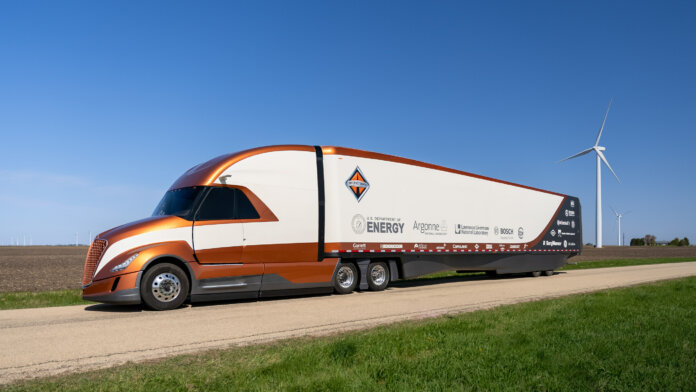Navistar says the International SuperTruck II yields 16 miles per gallon fuel efficiency through hybridization and a 170% improvement in freight efficiency, among other advancements, over the 2009 baseline vehicle, its International SuperTruck I.
SuperTruck II also proves innovative technical approaches to weight reduction from rolling resistance technologies, aerodynamic improvements and powertrain technologies designed to deliver premium freight efficiency to assist in reducing U.S. dependency on fossil fuels in the commercial vehicle sector.
“With co-funding by the DOE, Navistar engineers experimented with prospective technologies not currently available in the Class 8 truck market to accelerate the impact of sustainable mobility,” says Russ Zukouski, chief engineer, global innovation and principal investigator, for the Supertruck programs.
“The team concentrated its design on high-voltage electrification, utilizing hybrid technology on a path toward full electrification that has the potential to be commercialized in fully electric vehicles and improve customers’ total cost of ownership and business operations.”
With a shared program goal of increasing Class 8 vehicle efficiency and reducing the U.S. dependance on fossil fuels, International SuperTruck II focused on the next generation of vehicle efficiency improvements through hybridization and aerodynamics. This resulted in a demonstration of 170% improvement in vehicle freight efficiency, 55% engine brake thermal efficiency, assessed TCO opportunities for individual technologies, and high-voltage electrification efforts modeling hybrid technologies that can be utilized for fully electric vehicles.
“Navistar is the only OEM to build a trailer to provide the most accurate testing results possible,” said Dean Oppermann, chief engineer, Advanced Truck. “It includes a 100% composite box designed for minimum aerodynamic drag with light weight, integrated cross members, controlled underbody flow with composite aero treatments, next-generation solar panels with connectivity options, and ride height control.”
International SuperTruck II was built as a hybrid vehicle featuring a combustion engine with high-voltage accessories and technologies, developed in partnership with Bosch. Engine improvements were made in key areas including combustion, friction, gas exchange and airflow through the engine. A redesigned cylinder head with dual overhead cam engine and enhanced fuel system resulted in a 2% fuel economy improvement when compared to International SuperTruck I. Aftertreatment system improvements included diesel exhausted fluid dosing, improved mixing and lower restrictions, new selective catalytic reduction formulations for high-NOx reduction and reduced cold-start activation time.
See International SuperTruck II in action here.




